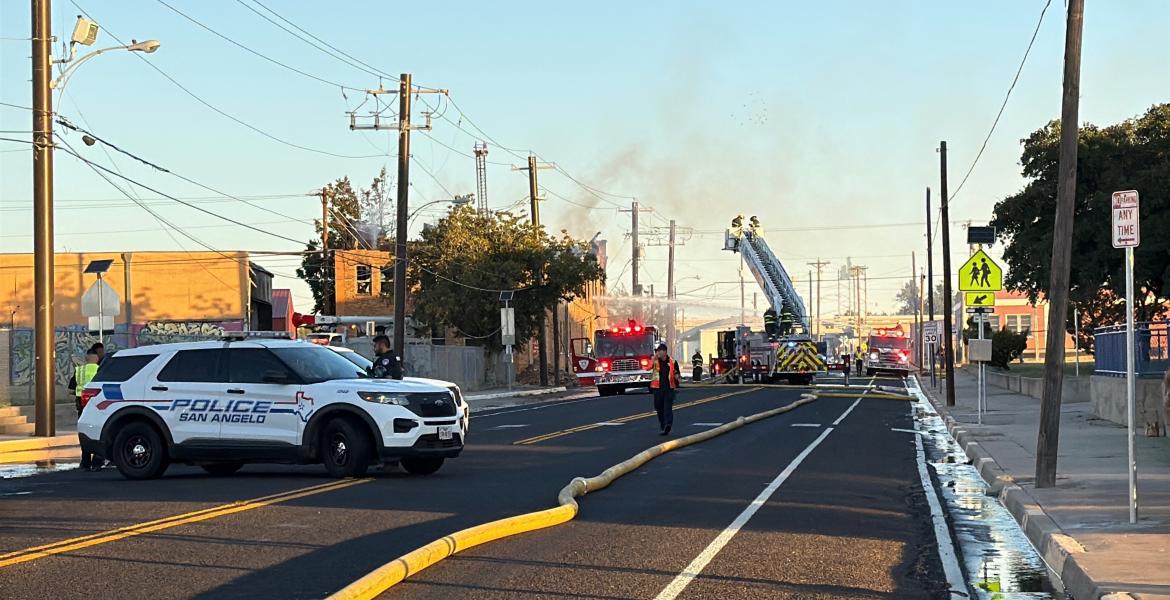SAN ANGELO, TX — The administration office at the San Angelo ISD anticipated gains on the state accountability A-F ratings officially released today by the Texas Education Agency (TEA), and was certainly pleased their letter grade increased from a “C” to “B.” The ratings were first announced at around 5:30 p.m. Wednesday.
The rating measures three main performance areas for the district overall. Each individual school in the district is given an A-F grade as well. The rating is based on primarily the results of standardized testing, called the State of Texas Assessments of Academic Readiness, or STAAR test. It is a multiple choice standardized test students in grades 3-12 must take during the school year. Of the three categories, the STAAR results play an outsized role in determining the A-through-F grade. The three TEA categories are “Student Achievement,” “School Progress,” and “Closing the Gaps.” San Angelo ISD scored a B, B, and C respectfully in each of the three categories.
San Angelo ISD Superintendent Carl Dethloff said the biggest challenge for San Angelo ISD from the previous few years after the A-F system was introduced was in “Closing the Gaps.” Specifically, some San Angelo ISD students were behind a couple of grade levels in their literacy — reading and writing skills. “English Language Proficiency” makes up 10 percent of the “Closing the Gaps” score.
State A-F data trends indicate Districts with a higher poverty rate — San Angelo ISD has about 60 percent of its students who are considered economically disadvantaged — struggle more with literacy and foundational skills than districts that are more affluent. While more affluent school districts across the state historically have higher literacy rates when less economically disadvantaged students are in the population.
Dethloff and his cadre of assistant superintendents and the San Angelo ISD school board invested human resources and money into improving the literacy rate of San Angelo’s students. In the 2019 ratings, Growth Status of the Reading for all students narrowly missed the target score of 66, earning a 63 according to the A-F Rating. Of economically disadvantaged students, the district scored a 60 of its goal of 64. The TEA Growth Status index measures the amount of improvement over the previous year’s TEA rating. In this case the numbers aforementioned measured “English Language Proficiency”, or ELP.
Dethloff said the San Angelo ISD Board of Trustees reallocated resources to implement a program designed to increase literacy. San Angelo has a high population of students who learned English as a second language, with Spanish the language used at home. They also recognized students coming from what school officials call “under-resourced families” — a politically correct way of saying “poor” — need additional support. But to solve the ELP deficiency, district leadership felt they needed a program that addressed literacy for all students, regardless of economic status or reading level, and that would require spending money, Dethloff said.
What was launched at the San Angelo ISD was what they called Educator and Learner Profiles. When Dethloff makes speeches, he always refers to the four pillars of the San Angelo ISD profiles.
“The traditional pedagogy of a teacher in front of a classroom lecturing students doesn’t work as well as it did when we were in school” Dethloff said. Students are digitally connected inside and outside of the schoolhouse in our modern era and expect engagement and opportunities to create and collaborate, he said. In San Angelo ISD, learning is arranged into four categories and the syllabus is modified to allow more hands-on learning tasks that encourage collaboration, critical thinking, communication, and creativity.
In addition to the learning profiles, the San Angelo ISD adopted a community-based accountability program (CBAS) that measures more than the STAAR testing will reveal. In particular, in literacy, the CBAS incorporates not only Section 504 Special Education programs, and English as a Second Language measurements, but also measures participation in honor societies and extracurricular activities like speech and debate.
Changing teaching tactics is hard to implement as a system across a large workforce at 25 schools. To do that, Dethloff looked at Georgetown ISD’s progress at implementing similar broad-sweeping reforms in procedures across a large district. From there he hired away Dr. Jana Rueter who was spearheading Georgetown ISD’s efforts. Except Dethloff wanted to modify the program to focus on literacy. Rueter joined the San Angelo ISD as its Executive Director of Curriculum Development in April 2016. Her husband, John, also serves the district as the principal of McGill Elementary. Convincing the Rueters to move from the trendy Austin area to San Angelo wasn’t too difficult. San Angelo is also where Rueter, a Central High, Texas Tech, and Texas A&M alum grew up. After earning her masters at Texas A&M, she earned a Ph. D. at the University of Texas.
“A spent the first year here mostly observing,” Rueter said. By 2017, however, she formed the plan now implemented, with special emphasis on literacy in response to the lagging STAAR results in that area.
The plan required the school board to reallocate money from other areas to hire a consulting group. Her consultants work with individual teachers to redefine teaching practices inside the classroom. The term “consultant” has bad connotations in local political circles, but in this case, Rueter argued, we aren’t adding staff at the administrators’ level. The consultants are temporary enhancements, helping teachers learn effective teaching techniques for the modern student, without the long-term impact on the district’s payroll. Payroll consumes the large majority of the district’s $115 million annual operations (M&O) budget.
From 2018, here is an interview with Rueter:
[[{"fid":"61544","view_mode":"wysiwyg","fields":{"format":"wysiwyg"},"type":"media","field_deltas":{"1":{"format":"wysiwyg"}},"attributes":{"class":"media-element file-wysiwyg","data-delta":"1"}}]]
Rueter said while literacy was a major focus two years ago, her team has expanded into improving all academic areas, particularly STEM skills throughout the district. “The chief priority is academic success,” she said. A big measurement of academic success is post-secondary preparedness, whether it is follow-on technical training or college.
CBAS takes into account SAT and ACT scores, military enlistment, and mentorship/internships for those pursuing careers not requiring a college degree.
Rueter said the best way these goals are achieved are not by teaching the STAAR test, but “We teach critical thinking.”
This video explains how the CBAS and profile system responds to needs in the modern, and in many cases, local workforce, Rueter said.
[[{"fid":"61545","view_mode":"wysiwyg","fields":{"format":"wysiwyg"},"type":"media","field_deltas":{"2":{"format":"wysiwyg"}},"attributes":{"class":"media-element file-wysiwyg","data-delta":"2"}}]]
Dethloff claimed the efforts have “100 percent re-aligned the culture inside the San Angelo ISD.” From feedback of parents and community leaders, he found that it was hard for anyone to argue against the learner profiles — collaboration, critical thinking, communications ability, and creativity.
Dethloff said San Angelo’s school board is a very special entity when compared to the citizen leadership of all of the approximate 1200 school districts in Texas. The members of the board work well with the administration, and together, the district’s leadership was able to look beyond just meeting the standards of the TEA’s A-F grading system. Instead, the district has created a learning system that larger districts in Texas are benchmarking.
“While we are proud of the academic gains we are seeing districtwide, we have many areas of improvement across our district. We owe it to our students, community, and parents to increase our literacy rates, bolster our student’s understanding of mathematical concepts, and set them up for academic success in all of our core content areas,” Dethloff said. “We will continue to provide additional academic supports and professional learning for staff until all students experience academic success. Our mission holds true – we will continue to engage students in a relevant and inspiring education that produces future ready graduates.”
Here is how each of the schools scored in the 2019 TEA Accountability Ratings:
| School | Grade | Score | Description |
|---|---|---|---|
| FT CONCHO EL | A | 90 | Kindergarten - Grade 5 |
| SANTA RITA EL | A | 91 | Kindergarten - Grade 5 |
| CENTRAL H S | B | 81 | Grade 9 - Grade 12 |
| LAKE VIEW H S | B | 82 | Grade 9 - Grade 12 |
| BLACKSHEAR HEAD START | B | 85 | Early Education - Pre Kindergarten |
| FANNIN EL | B | 80 | Early Education - Grade 5 |
| GLENMORE EL | B | 82 | Pre Kindergarten - Grade 5 |
| RIO VISTA HEAD START | B | 85 | Pre Kindergarten |
| GLENN MIDDLE | C | 71 | Grade 6 - Grade 8 |
| ALTA LOMA EL | C | 70 | Early Education - Grade 5 |
| BOWIE EL | C | 73 | Kindergarten - Grade 5 |
| BRADFORD EL | C | 71 | Pre Kindergarten - Grade 5 |
| CROCKETT EL | C | 72 | Kindergarten - Grade 5 |
| MCGILL EL | C | 76 | Pre Kindergarten - Grade 5 |
| REAGAN EL | C | 73 | Early Education - Grade 5 |
| BONHAM EL | C | 77 | Kindergarten - Grade 5 |
| LEE MIDDLE | D | 61 | Grade 6 - Grade 8 |
| SAN JACINTO EL | D | 60 | Kindergarten - Grade 5 |
| LAMAR EL | D | 60 | Kindergarten - Grade 5 |
| LINCOLN MIDDLE | F | 59 | Grade 6 - Grade 8 |
| AUSTIN EL | F | 48 | Early Education - Grade 5 |
| BELAIRE EL | F | 55 | Kindergarten - Grade 5 |
| GOLIAD EL | F | 54 | Kindergarten - Grade 5 |
| HOLIMAN EL | F | 56 | Kindergarten - Grade 5 |
| CARVER ALTER LRN CTR | NA | NA | Grade 5 - Grade 12 |
Subscribe to the LIVE! Daily
Required






Post a comment to this article here: